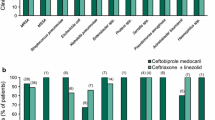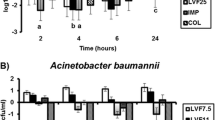Abstract
The antibacterial activities of ciprofloxacin versus ceftazidime againstKlebsiella pneumoniae in vitro andin vivo were compared. Although there was only a minor difference in MBC values between both drugs ciprofloxacin demonstrated a high and dose-dependent bacterial killing ratein vitro and in lungs of leukopenic rats in contrast to the more time-dependent bactericidal activity of ceftazidime. After treatment of aK.pneumoniae pneumonia and septicemia the efficacy of ciprofloxacin was only slightly influenced by the mode of administration, either at 6-h intervals or continuously, whereas ceftazidime was far more effective after continuous administration. This resulted in a superior efficacy of ciprofloxacin after intermittent treatment as compared to ceftazidime, whereas ceftazidime was more effective after continuous administration as compared to ciprofloxacin. Also ciprofloxacin proved to be bactericidal against bacteria that were not actively growing, bothin vitro andin vivo, whereas ceftazidime was not.
Similar content being viewed by others
References
Klastersky J, Glauser MP, Schimpff SC, Zinner SH, Gaya H, and The European Organization for Research on Treatment of Cancer antimicrobial therapy project group. Prospective randomized comparison of three antibiotic regimens for empirical therapy of suspected bacteremic infection in febrile granulocytopenic patients. Antimicrob Agents Chemother 1986;29:263–70.
Kramer BS, Pizzo PA, Robichaud KJ, Witesbsky F, Wesley R. Role of serial microbiologic surveillance and clinical evaluation in the management of cancer patients with fever and granulocytopenia. Am J Med 1982;72:561–8.
Sculier JP, Weerts D, Klastersky J. Causes of death in febrile granulocytopenic cancer patients receiving empiric antibiotic therapy. Eur J Cancer Clin Oncol 1984;20:55–60.
Chalkley LJ, Koomhof HJ. Antimicrobial activity of ciprofloxacin againstPseudomonas aeruginosa, Escherichia coli, andStaphylococcus aureus determined by the killing curve method: Antibiotic comparisons and synergistic interactions. Antimicrob Agents Chemother 1985;28:331–42.
Zeiler HJ. Evaluation of the in vitro bactericidal action of ciprofloxacin on cells ofEscherichia coli in the logarithmic and stationary phase of growth. Antimicrob Agents Chemother 1985:28:524–7.
Cozens RM, Tuomanen E, Tosh W, Zak O, Suter J, Tomasz A. Evaluation of the bactericidal activity of ß-lactam antibiotics on slowly growing bacteria cultured in the chemostat. Antimicrob Agents Chemother 1986;29:797–802.
Bakker-Woudenberg IAJM, van den Berg JC, Michel MF. Therapeutic activities of cefazolin, cefotaxime, and ceftazidime against experimentally inducedKlebsiella pneumaniae pneumonia in rats. Antimicrob Agents Chemother 1982;22:1042–50.
Thonus IP, de Lange-Macdaniel AV, Otte CJ, Michel MF. Tissue cage infusion: a technique for the achievement of prolonged steady stage in experimental animals. J Pharmacol Methods 1979;2:63–9.
Sachs L. Evaluation of biologically active substances based on dosage — dichotomous effect curves. In: Sachs L, ed. Applied statistics. A handbook of techniques. New York: Springer Verlag, 1982;224–8.
Bennett JV, Brodie JL, Benner EJ, Kirby WMM. Simplified accurate method for antibiotic assay of clinical specimens. Appl Microbiol 1966;14:170–7.
Bakker-Woudenberg IAJM, Berg van den JC, Vree TB, Baars AM, Michel MF. Relevance of serum protein binding of cefoxitin and cefazolin to their activities againstKlebsiella pneumoniae pneumonia rats. Antimicrob Agents Chemother 1985:28:654–9.
Bergogne-Berezin E, Berthelot G, Even P, Stern M, Reynaud P. Penetration of ciprofloxacin into bronchial secretions. Eur. J Clin Microbiol 1986:5:197–200.
Hooper DC, Wolfson JS. The fluoroquinolones: pharmacology, clinical uses, and toxicities in humans. Antimicrob Agents Chemother 1985:28:716–21.
Nichol KL, Peterson, Fasching CE, Gerding DN. Ciprofloxacin penetration into extravascular spaces in a rabbit model. Antimicrob Agents Chemother 1984:26:935–6.
Wise R, Lockley RM, Webberly M, Dent J. Pharmacokinetics of intravenously administered ciprofloxacin. Antimicrob Agents Chemother 1984:26:208–10.
Author information
Authors and Affiliations
Rights and permissions
About this article
Cite this article
Roosendaal, R., Bakker-Woudenberg, I.A.J.M., van Den Berghe-Van Raffe, M. et al. Influence of dose frequency on the therapeutic efficacies of ciprofloxacin and ceftazidime in experimental Klebsiella pneumoniae pneumonia and septicemia in relation to their bactericidal activities in vitro. Pharmaceutisch Weekblad Scientific Edition 9 (Suppl 1), S33–S40 (1987). https://doi.org/10.1007/BF02075257
Issue Date:
DOI: https://doi.org/10.1007/BF02075257




